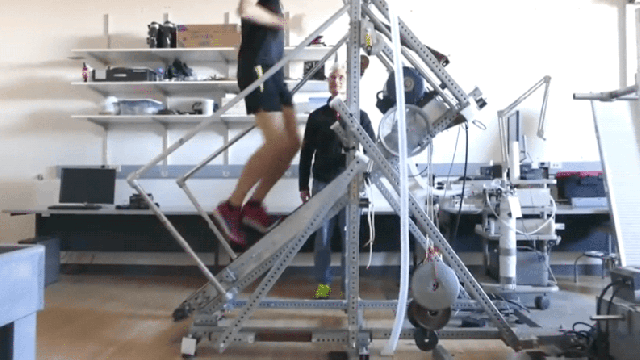Standard treadmills only reach a maximum incline of around 9 degrees. But this one, developed by a team of physiologists at the University of Colorado Boulder, goes all the way to 45 degrees. The unique contraption is providing some insights into the best strategies for extreme uphill running.
This is apparently the first time that researchers have investigated the metabolic costs of human running and walking on steep inclines — and they actually found something pretty interesting.
For the study, published in the Journal of Applied Physiology, the researchers recruited 15 competitive mountain runners, who walked on the custom-built treadmill at seven different angles ranging from 9 to 39 degrees (interestingly, the researchers also learned that the athletes could no longer retain their balance beyond 40 degrees). The speed of the treadmill was set so that the vertical rate of ascent was constant. And as it turns out, there’s a range of slope angles that allow athletes to ascend a mountain most quickly.
The team led by Rodger Kram discovered that, for either running or walking, slopes between 20 and 30 degrees require the same amount of energy to climb at the same vertical velocity. In other words, there’s an optimal range of slope angles where the degree of incline doesn’t matter, and where the same rate of ascent requires the same rate of energy expenditure. The researchers are calling it the “Goldilocks Plateau”.
It’s a strange, and even unintuitive result. Kram used an analogy to describe his team’s findings:
Imagine that you are standing in Colorado at a trailhead where the base elevation is 2,743m. Your friend challenges you to race to the summit of the mountain, which tops out at 3,743m, i.e. 1,000 meters of elevation gain. There are several different trails that go to the summit. They are all pretty steep and some are extremely steep. One trail averages 10 degrees incline and the sign says it is 5km long. A second trail averages 30 degrees, but is only 2km long. A third trail averages 40 degrees, but only 2km long. To get to the summit the fastest, which trail should you choose and should you walk or run?
Based on our research, we now know that choosing the second trail (30 degrees) and walking as fast as you can within your aerobic capacity is the fastest way to go.
Cool right? The experiment might seem frivolous, but it’s important for runners who participate in vertical kilometer (VK) races, which are becoming quite popular in mountainous regions. In these races, athletes run or walk up steep slopes ranging between 10 and 30 degrees, and often to heights approaching an entire kilometre over a distance less than 5 km.
Read the entire study at the Journal of Applied Physiology: “Energetics of vertical kilometer foot races; is steeper cheaper?“.
